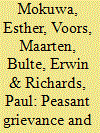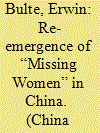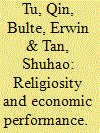|
|
|
Sort Order |
|
|
|
Items / Page
|
|
|
|
|
|
|
| Srl | Item |
| 1 |
ID:
106029


|
|
|
|
|
| Publication |
2011.
|
| Summary/Abstract |
Was the civil war in Sierra Leone (1991-2002) fought for diamonds, or was it a peasant insurgency motivated by agrarian grievances? The evidence on both sides is less than conclusive. This article scrutinizes the peasant insurgency argument via a more rigorous methodology. Hypotheses concerning intra-peasant tensions over marriage and farm labour are derived from an examination of the anthropological literature. These are tested using econometric tools, applied to data from a randomized survey of 2,239 households in 178 villages surrounding the Gola Forest in eastern and southern Sierra Leone, the cradle of the war. It is shown that a decade after the war ended peasant disputes over marriage continue to mark out an incipient class divide in isolated rural communities, as evidenced by cases presented in local courts and family moots. Disputes mainly involve a village elder suing a young man with weak social protection. Fines are exceptionally high, and mostly paid off in the form of coerced farm labour. It is argued that grievance over this long-standing form of labour exploitation fed insurgency, and contributed to the otherwise puzzlingly high levels of peasant-upon-peasant violence associated with the war in Sierra Leone.
|
|
|
|
|
|
|
|
|
|
|
|
|
|
|
|
| 2 |
ID:
183242


|
|
|
|
|
| Summary/Abstract |
Empirical evidence suggests that close to 100 million women are “missing” worldwide. We revisit the empirical evidence for China, the country with the most missing women. Nearly ten million girls born in the 1980s and 1990s who were “missing” according to earlier census data can be found again in the 2010 population census. We discuss two possible explanations for the re-emergence of these formerly missing girls: the delayed registration of girls owing to economic reasons, and the response to amendments to the Chinese Statistics Law in 2009 and policy changes in the 2010 population census. Using the most recent statistics, we document patterns of the underreporting of women over time and across regions as well as explore the basic determinants of underreporting of women. Important policy challenges remain. For the unregistered children, the lack of access to public services will increase their vulnerability and adversely affect their quality of life.
|
|
|
|
|
|
|
|
|
|
|
|
|
|
|
|
| 3 |
ID:
103908


|
|
|
|
|
| Publication |
2011.
|
| Summary/Abstract |
We use results from a household survey to explore the relation between religiosity and our proxy for income among herders in rural Tibet. Our main results are twofold. First, there exists a positive relation between the intensity of religious beliefs (the main 'output' of the religious production process) and income - beliefs about the afterlife affect production and savings decisions today. Second, and perhaps more surprising, we find an inverted U-shaped relation between religious 'inputs' (time and money spent in the temple) and income. While it is possible to use too much resources as religious inputs, we find that the great majority of the respondents is on the upward sloping part of the curve linking economic performance to religious inputs. We present tentative evidence that the positive impact of religiosity and income may be explained by status (reputation) and information effects associated with producing religiosity.
|
|
|
|
|
|
|
|
|
|
|
|
|
|
|
|
| 4 |
ID:
118962


|
|
|
|
|
| Publication |
2013.
|
| Summary/Abstract |
Witchcraft has been documented across the globe. The widespread occurrence of such beliefs in modern Africa affects politics, economic development, and poverty alleviation. Anthropologists have analysed the semiotics of African witchcraft, but there is less information on distributional issues. An important question is which communities are most affected, and why? Using data from a survey of 182 villages and 2,443 household heads in the Gola Forest region of eastern Sierra Leone, we examine three manifestations of witchcraft - concerns, conflicts, and detection. We find that where patrimonial relations of agrarian production remain strong, and in settings where market forces are now well established, witchcraft is less of a concern. By contrast, witchcraft manifestations are higher in communities experiencing the competing pull of patrimonial and market norms. Witchcraft, we conclude, is a product of normative ambiguity.
|
|
|
|
|
|
|
|
|
|
|
|
|
|
|
|
|
|
|
|
|